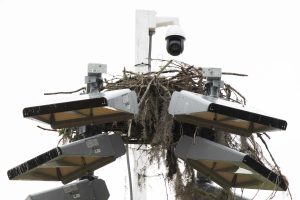Between innings of his intramural softball games, Mark Hostetler will sometimes ask student participants about the high-pitched chirps and shrieks emanating from above their heads.
“We always hear that bird screaming,” the students often say. “What is that bird?”

To many of the people using the fields behind the University of Florida’s Southwest Recreation Center, the sounds are just background noise.
“After I sit with them and talk about the ospreys and what they’re doing and the camera, they get out their smartphones and say, ‘Wow. I can actually see it,’” said Hostetler, a professor of wildlife ecology and conservation at UF’s Institute of Food and Agricultural Sciences (UF/IFAS).
For the past two years, the top of a light pole between the easternmost softball fields has served as the seasonal home of Stella and Talon, ospreys that have fashioned a 100-pound nest from moss, twigs and other organic material, 75 feet above the human action below. In just a few days, the birds are expected to become the parents of three chicks. And thanks to a camera Hostetler’s team positioned just above the nest, video of the hatchings will be visible online.
Hostetler’s osprey webcam project began in 2016 after he noticed ospreys had crafted a nest atop a light pole in the right outfield of McKethan Stadium, UF’s official baseball field until 2020.
“I thought to myself, ‘This is a great educational opportunity,’” he said. “People see these ospreys, but they don’t really know much about their natural life history, what they’re doing in the nests.”
He put a camera above the nest, and it began broadcasting video footage streamed online. Game attendees could tune in and observe the birds during innings.
When Condron Ballpark replaced McKethan Stadium, Hostetler searched across campus for a new nest to film. He eventually settled on the intramural softball fields, where several nests were already located, and his team used a boom crane to position a camera above a nesting site. A pair of ospreys returned to the site — jokingly referred to as “Home Plate” and “The Cheap Seats” — early this year, and the female began laying eggs in February.
Based on the incubation period of ospreys, Hostetler guesses the first egg will hatch around April 2.
The chicks will unknowingly emerge from their eggs before a sizeable audience; about 70,000 people from across the world tune in each year to watch the ospreys.
Hostetler hopes viewers can learn a valuable lesson about conservation.
“Everything is connected,” he said. “The birds that you hear and the osprey families in the nests are dependent on the habit that’s around them. If it’s not healthy because we’re putting too much fertilizer on our property and introducing too many chemicals, then it affects the availability of fish that the birds eat and feed their chicks. Urban areas are a combination, of course, of human modification, but we can do it in a way that doesn’t disrupt the wildlife in the area.”
Observe the ospreys, learn more and make donations to support the Osprey Cam project by visiting https://wec.ifas.ufl.edu/extension/ospreycam/.
 2
2
